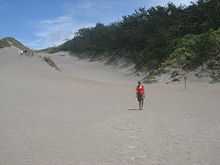Sigatoka Sand Dunes

They are the product of erosion in the coastal hinterland and coastal dune forming processes. The extensive dune system covers an area of 650 hectares and comprises a series of parabolic sand dunes of various ages and activities. The dunes range from around 20-60m tall.
The dunes have been forming over thousands of years and archaeological excavations here have uncovered pottery more than 2600 years old, as well as one of the largest burial sites in the Pacific. Evidence of the past is clearly visible throughout the dune system as pottery scatters, stone tools, human remains and other archaeological relics continue to be uncovered by natural processes.
In 1999 it was proposed as a World Heritage Site but has not been accepted so far.
- UNESCO World Heritage Centre – tentative list
- New Zealand Journal of Botany – Sigatoka Sand Dunes 1981
National Park status
The dunes were designated Fiji's first National Park in July 1989 and consequently came under the management of the National Trust of Fiji Islands.[1] The dunes are now an important educational and recreational point for locals and tourists. Apart from being a key tourist destination, the dunes are an important source of archaeological artificats and information for local and foreign universities and archaeological institutes.